Cawthron colleague Anastasija Zaiko presented our collaborative project at DNAqua-Net’s virtual meeting.
Click here for abstract!

Cawthron colleague Anastasija Zaiko presented our collaborative project at DNAqua-Net’s virtual meeting.
Click here for abstract!

The Alliance for Coastal Technologies is pleased to announce the release of Performance Demonstrations for several Harmful Algal Toxin Detection Systems including 1) MBio’s HAB Toxin MC/CYN Gen 1 System (microcystin/cylindrospermopsin); 2) Beacon Analytical Systems’ Field Tube Kits (microcystin and domoic acid [beta version]); and 3) Phytoxigene real-time qPCR kits: CyanoDTec (microcystin/nodularin, cylindrospermopsin, saxitoxin, cyanobacterial 16S) and DinoDTec (saxitoxin in dinoflagellates).
The kits were put through a series of laboratory (Moss Landing Marine Labs [CA], Bowling Green State University [OH]) and field deployments in Long Island Sound (NY), the Great Lakes (MI), and the Monterey Bay (CA) area.
The Evaluation Team included: Tom Johengen, Heidi Purcell, Deanna Fyffe (Cooperative Institute for Great Lakes Research), G. Jason Smith, Holly Bowers (Moss Landing Marine Labs), Dan Schar (Hawaii Institute of Marine Biology), Tim Davis (Bowling Green State University), Earle Buckley (Buckley Environmental), and Mario Tamburri (University of Maryland Center for Environmental Sciences).
The team wishes to acknowledge the support of all those who helped plan and conduct the demonstrations, analyze the data, and prepare these reports. In particular, we would like to thank our Technical Advisory Committee: Joel Allen, U.S. Environmental Protection Agency, Dianne Greenfield, Dr. Dianne Greenfield, City University of New York (CUNY), Meredith Howard, California State Water Resources Control Board, Keith Loftin, U.S. Geological Survey for their advice and direct participation in various aspects of these demonstrations. Earle Buckley also provided critical input on all aspects of this work and served as the independent Quality Assurance Manager. This work has been coordinated with, and funded by, the National Oceanic and Atmospheric Administration, Integrated Ocean Observing System program.
H. Bowers was recently part of the working group formed to flesh out the strategy for implementation of a National Harmful Algal Bloom Observing Network (NHABON). This document serves as a springboard for moving forward with integrating local, state, and regional capabilities. An operational system would serve to provide early warning and forecasting toward a better understanding of HAB dynamics and their impacts on local economies. In 2020, there was bi-partisan support in Congress to move ahead with such an approach.
Implementation strategy: http://www.ioosassociation.org/sites/nfra/files/NHABON_StrategyDocWeb_Draft4.pdf
Full framework document: https://cdn.coastalscience.noaa.gov/page-attachments/news/NHABON_Framewk_WkshpReport_12-18-20_Final.pdf
Holly had an awesome experience as a visiting researcher at Cawthron (New Zealand) in 2020! Although she has previously collaborated with some of their team, those relationships were expanded upon and new ones were formed during this visit. She worked closely with the Biosecurity Team to run two experiments testing different filter types and filtration times for efficient eDNA and eRNA capture, using the dinoflagellate Alexandrium as a model species. An eDNA/eRNA review paper with a biosecurity angle is in the works. With the Safe New Zealand Seafood Programme she worked to expand geographic specificity testing for qPCR assays targeting four species within the toxin-producing genus Pseudo-nitzschia. A continuing collaboration with the team aims to characterize species diversity and toxin production of a subset of Pseudo-nitzschia species around New Zealand. She returns with an expanded knowledge base and heaps of ideas for future collaborations!

Recently, Holly (in conjunction with Ubiquitome) gave a webinar about using the handheld qPCR machine in the field. The webinar was designed to be interactive such that attendees from around the world could ask questions and share in the challenges of field-based testing.
You can catch the webinar here!
https://zoom.us/recording/play/2D_M2xlXlu6vK9GFyTC9n15mGoeG42OCyxZU6R4qpW1W4HUuliDMTMtnXEqykUf2?continueMode=true
Today we embarked on our first freshwater field sampling at Pinto Lake! We pulled up to the empty parking lot that overlooked the quiet and serene lake. The chilly fog was gently sitting above the still lake and the only sign of life was from the 3 dozen Canadian geese sitting on the shore. My lab back in Florida focuses on fecal contamination and all I could think about was how this would be the perfect spot if one was looking for GFD (avian specific fecal gene sequence) markers. We took some samples using a syringe and pushed water through a 0.2-micron pore filter. If you are looking for a new workout routine, I highly recommend trying to push at least 50 mLs of freshwater through a filter with such a minuscule pore size. We filtered in order to try and detect any microcystis, which is a freshwater cyanobacterium that can produce a toxin that affects the liver very rapidly and can sicken or kill humans and wildlife. There have been cases where dogs have drunk from lakes or ponds that have the microcystin toxin and have died within 24 hours (Backer). There have also been famous cases in areas around Lake Erie where the local citizens were advised the water supply contained unsafe levels of microcystin.
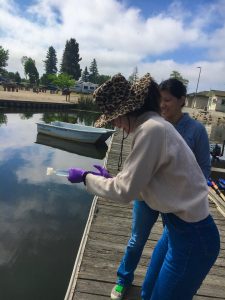
Backer, Lorraine C et al. “Canine cyanotoxin poisonings in the United States (1920s-2012): a review of suspected and confirmed cases from three data sources.” Toxins vol. 5,9 1597-628. 24 Sep. 2013, DOI:10.3390/toxins5091597
-Cami Wilson
This Thursday, we headed out to our first field sampling/processing event with the new handheld qPCR. Our lucky contestant was none other than the breathtaking Monterey Bay Aquarium! Not only did we have stunning views out to the Pacific Ocean, but it was a good stepping stone since they provided electricity. Normally out in the field, there would not be any electrical outlets so this provided us with a perfect opportunity to see how electricity could affect our qPCR product. We are still in the midst of trying to find a new solution for a bead shaker vortex, used to lyse the phytoplankton and extract DNA since it is not battery powered and needs an electrical outlet. Some ideas are using a car battery for its power source out in the field…feel free to let us know your ideas!
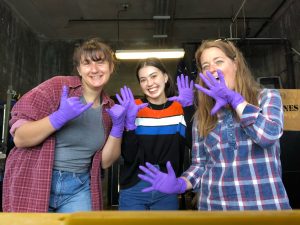
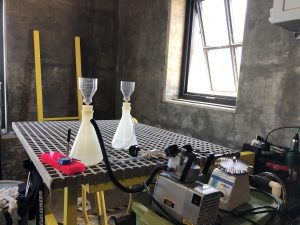
-Cami Wilson
It was 8:30 AM, I step out of the car to see this white rustic building matching the cold foggy weather. You could hear sea lions barking in the background from the marina behind me. {This is going to be my home for the next 10 weeks.}
Walking down the cold dark quiet hallway, I wondered to myself if this was the right place. Sure enough, Dr. Holly Bowers pokes her head out of this rather large but cozy office. I prop my stuff on an open spot on the desk and my tour of the laboratory and island begins!
Holly took me right down the street to visit the marine aquaculture laboratory. Shown below is one of the tanks that starfish and sea urchins thriving in!
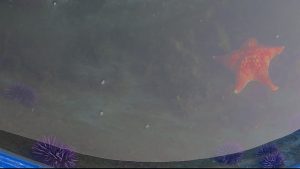
Here is a video of the marine aquaculture to get a broader insight into what it looks like!
Today was very eye-opening to see a prolific amount of various species thriving in such an environment so close to me. I was born and raised in the hot and humid Florida, a complete 180 from Monterey California’s environment. In Florida, I only occasionally see a Great Blue Heron or Muscovy ducks in the wild. In just my first day in Monterey, I saw sea lions, otters, an array of bird species, gophers, ground squirrels, and an abundant number of baby bunnies roaming in the wild!
-Cami Wilson
It has been awhile since EBL has formally participated in Open House! This year, we had a fun time debuting our handheld qPCR devices to members of the community. Visitors first entered the ‘Twilight Zone’ of Dr. Colleen Durkin’s lab and walked through marine snow and representative organisms found in the deeper ocean. They were then introduced to a surface water net tow, collected fresh that morning from the Monterey Wharf, teeming with diatoms and dinoflagellates (thanks for cooperating, Mother Nature!). EBL talked about how it’s complicated to pick out specific harmful algal species of interest from that gimmish, and how we are using genetics to do that! Folks were amazed to see we can do this from an iPhone, on a battery powered instrument, in the field!
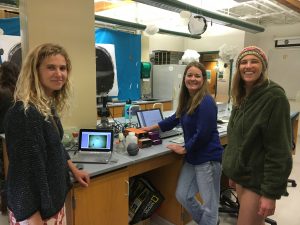
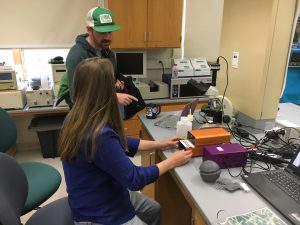
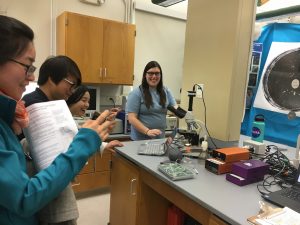
Yes, we count cool toys as lab members sometimes! The Liberty16 is a handheld qPCR device and we can’t wait to get out in the field with it soon to detect Harmful Algal Bloom (HAB) species in real-time to support various stakeholders around the Monterey Bay area! Stay tuned for more updates as we roll out this exciting technology out of Ubiquitome in New Zealand.
